
The saga of the planetary nebula Jones-Emberson 1 began 148 years before Harvard Observatory astronomers Rebecca Jones and Richard Emberson discovered it in the faint constellation Lynx. In 1790, William Herschel discovered a small, nebulous glow about 2½° northwest of 27 Lyncis. He moved on without noticing a second, fainter glow nearby. That object was discovered 66 years later by William Parsons, Earl of Rosse, through his 72-inch “Leviathan” reflector. Both were later added to John Dreyer’s New General Catalogue as NGC 2474 and NGC 2475 and classified as dim elliptical galaxies separated by just 25″.
Then, in 1939, Jones and Emberson published a paper in that year’s Harvard College Observatory Bulletin August issue, announcing that “a recent photographic plate [revealed] a faint nebular ring has been detected joining two condensations, NGC 2474 … and NGC 2475.”
Their error did not become apparent for more than 40 years, until Nancy and Ronald Buta of McDonald Observatory realized that Jones and Emberson had not photographed NGC 2474 and 2475 at all. Instead, they had discovered an unusual planetary nebula half a degree to the north, about 1,600 light-years away, that had never been seen before.
In addition to its unconventional discovery story, Jones-Emberson 1 looks weird as far as planetary nebulae go. Images show a familiar ring structure. But what makes it strange are two brighter lobes connected by opposing faint arcs of nebulosity. This unusual cloud structure has given rise to the nickname of the Headphone Nebula.









